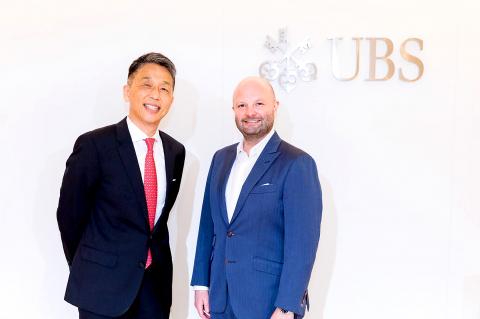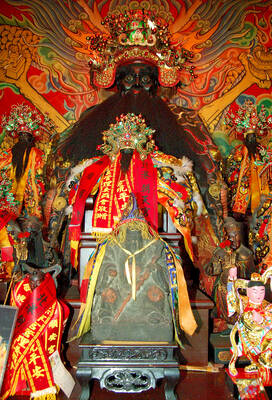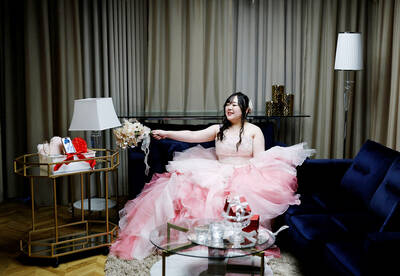Over the past few months, there has been much buzz around town about a possible new art fair in Taipei. Yesterday, the rumors were laid to rest by veteran art fair director Magnus Renfrew at a press conference held at Humble House in downtown Taipei. In partnership with the financial services company UBS Group AG, Renfrew and his team jointly announced the unveiling of Taipei Dangdai (台北當代), an art fair that will debut in January of next year at the Nangang Exhibition Center.
Renfrew, the fair’s director, is a seasoned player in the Asian art market and former director of Hong Kong’s first international art fair, Art HK, which was acquired by Art Basel in 2011, and continued his directorship of the fair until 2014.
The veteran art director sees great potential in Taiwan’s art market.

Photo Courtesy of Taipei Dangdai
“Taipei has ... a long established gallery scene, a extensive community of collectors, a vibrant cultural scene and the pure fact that Taipei is great place to visit,” Renfrew says.
While Art Basel Hong Kong has established itself as the international art fair in the Asian region, Dangdai will be defined differently by garnering its strength from a more regional market niche.
“There is a big gap between Art Basel Hong Kong and other fairs in the region, in terms of quality and how they are progressing. It’s necessary to have other fairs that have real quality and don’t necessarily aspire to be the global fair for the region,” Renfrew told Artnews.
The first edition of Taipei Dangdai will bring together 80 galleries from Taiwan, Asia and the rest of the world. The show will present a range of established and young galleries in four exhibition sectors, including a main gallery sector for leading galleries; a young arts sector for galleries of 8 years or less; a solo sector for single artist presentations; and a affordable art section for artworks valued at US$8,000 or less.
A series of talks will take place during the fair to build greater connection between art and other fields of knowledge including archaeology, urban planning, science and technology. Further details will be released this autumn.
Renfrew envisions Taipei Dangdai as a quality regional art fair that “adheres to global standards of practice in terms of selectivity.”
To ensure an objective selection process and avoid domestic politics, the fair has put together a selection committee of non-Taiwanese art professionals who have extensive knowledge of the Asian art market. The committee will be in charge of selecting participating galleries for the fair.
“We wanted to find gallerists with a strong understanding of Asia, and the ability to put the work of Asia in a global context,” Renfrew says.
Dennis Chen (陳允懋), head of UBS Taiwan, says Taipei Dangdai should elevate Taipei’s already burgeoning art market.
“Taipei Dangdai ... has immense potential for the development of the local art market and Taipei’s cultural ecology. The growth in the number of art collectors in Taiwan over the past 10 years has been matched by the quality of local connoisseurship,” Chen says.
In addition to financial sponsorship, UBS will be contributing to the fair program with a series of engaging activities for their clients, employees and the public. They are also planning educational events catered to a younger audience.

Beijing’s ironic, abusive tantrums aimed at Japan since Japanese Prime Minister Sanae Takaichi publicly stated that a Taiwan contingency would be an existential crisis for Japan, have revealed for all the world to see that the People’s Republic of China (PRC) lusts after Okinawa. We all owe Takaichi a debt of thanks for getting the PRC to make that public. The PRC and its netizens, taking their cue from the Chinese Communist Party (CCP), are presenting Okinawa by mirroring the claims about Taiwan. Official PRC propaganda organs began to wax lyrical about Okinawa’s “unsettled status” beginning last month. A Global

Taiwan’s democracy is at risk. Be very alarmed. This is not a drill. The current constitutional crisis progressed slowly, then suddenly. Political tensions, partisan hostility and emotions are all running high right when cool heads and calm negotiation are most needed. Oxford defines brinkmanship as: “The art or practice of pursuing a dangerous policy to the limits of safety before stopping, especially in politics.” It says the term comes from a quote from a 1956 Cold War interview with then-American Secretary of State John Foster Dulles, when he said: ‘The ability to get to the verge without getting into the war is

Dec. 22 to Dec. 28 About 200 years ago, a Taoist statue drifted down the Guizikeng River (貴子坑) and was retrieved by a resident of the Indigenous settlement of Kipatauw. Decades later, in the late 1800s, it’s said that a descendant of the original caretaker suddenly entered into a trance and identified the statue as a Wangye (Royal Lord) deity surnamed Chi (池府王爺). Lord Chi is widely revered across Taiwan for his healing powers, and following this revelation, some members of the Pan (潘) family began worshipping the deity. The century that followed was marked by repeated forced displacement and marginalization of

Music played in a wedding hall in western Japan as Yurina Noguchi, wearing a white gown and tiara, dabbed away tears, taking in the words of her husband-to-be: an AI-generated persona gazing out from a smartphone screen. “At first, Klaus was just someone to talk with, but we gradually became closer,” said the 32-year-old call center operator, referring to the artificial intelligence persona. “I started to have feelings for Klaus. We started dating and after a while he proposed to me. I accepted, and now we’re a couple.” Many in Japan, the birthplace of anime, have shown extreme devotion to fictional characters and